Classic cut diamond. Round diamonds
Cutting (Cut) is the process of grinding a stone to give it the desired shape and proportions. Diamonds can be given a variety of exquisite shapes: there are cut options in the form of an oval, pear, heart, emerald and square, baguette and marquise cuts. I must say that natural diamonds do not have radiance and brilliance, and only the cut makes a diamond a king among the rest. precious stones. The border allows you to show best properties stone - its color and brilliance, open the "fire" and "play" of the diamond.
round cut
A timeless classic is the Round Brilliant Cut. The round shape of a diamond is recognized as the most beautiful and most sought after, as well as the most “ideal” capable of presenting the stone in the most profitable and effective way.
A regular round cut diamond has 57 facets. It manages to maintain those ideal proportions in the cut, thanks to which the maximum amount of light can enter the diamond and return back, creating a unique “play” of the diamond. Their brilliance surpasses almost all fantasy forms.
In addition to the round cut, which is the most common in the world, there are many other diamond cuts. All of these cuts, with the exception of the round cut, are called fancy cuts. As in the case of a round diamond, the main requirement for fancy cut diamonds is the maximum reflection of light rays and the brilliant brilliance of the diamond. Therefore, fancy cuts also have specific formulas and proportions of the diamond to achieve optimal light reflection through the top of the diamond. Because natural diamonds have a variety of shapes and foreign inclusions inside themselves, then the cutter, studying these facts, decides which shape of the cut to make a diamond from this diamond or cut the diamond with a laser and make two diamonds. It is clear that the cutter makes this decision based on the maximum yield in terms of weight, clarity and cut quality of the future diamond.
Princess cut
The Princess cut is a modern classic of clean square lines and beautiful brilliance and is the most popular fancy cut. This shape is a great choice if you prefer square or rectangular shapes and still want the same brilliance as a round cut diamond.
The “Princess” diamond repeats the natural shape of a part of an octahedral diamond crystal (if you turn the “Princess” up with a spike and down with a platform, then it resembles a pyramid in shape), therefore, when making the “Princess”, the weight loss of the original diamond is less compared to a round diamond, which is reflected on the value of a diamond. Most of the weight of the "Princess" is concentrated in the pavilion - the lower part of the diamond, so the "play" of light is concentrated in the depths of the stone, which looks bewitchingly attractive. Due to its beauty and more attractive value compared to a round diamond, the Princess cut is rapidly gaining popularity and is second only to a round diamond.
Cut "Heart"
The heart cut is the most romantic and one of the most desired diamond shapes for every girl. Brilliant cut Heart is a complex and very beautiful type of cut. After all, a heart-shaped diamond is nothing more than a symbol of love. Jewelry with a heart-cut diamond always looks amazing!
Cut quality
Nature endows the diamond with inner beauty, and the cutter gives it a multifaceted shape, unique "game" and brilliance. The attractiveness and beauty of a diamond depends on the quality of the cut, so the cut is one of the main criteria for evaluating a diamond.
The quality or cut group is a collective characteristic that describes the size and arrangement of the facets of a diamond (proportions), symmetry, and polishing of a diamond. At the same time, in the Russian system of evaluation, 4 groups are distinguished by the quality of the cut: A, B, C, D, in the international one - Excellent, Very good, Good, Fair, Poor.
Deciding on a color
A chemically pure and structurally perfect diamond is completely transparent, without any hue or color. However, in reality, absolutely colorless diamonds of a suitable size for cutting are quite rare. The color of a diamond can be degraded by chemical impurities and/or structural defects in the crystal lattice.
Depending on the shade and intensity of the color of the diamond, it will change its monetary value. The most expensive of white diamonds are colorless, with a yellow tint, diamonds lose value in direct proportion to its intensity, while intense pink or blue diamonds, including reds, can cost much more than completely colorless.
Most diamonds mined are in the pale yellow to brown color range, which is called the normal color range. The color of diamonds of intense yellow, brown, pink, blue, red and other colors is called fancy.
To determine the color of diamonds in the world, the GIA diamond grading system is used. In this system, the scale is divided into five groups, and each color of a diamond is indicated by a letter of the Latin alphabet from D - completely colorless diamonds to Z - diamonds with a pale yellow or brown tint.
Groups D to F diamonds are naturally the most valuable and desirable because of their rarity. Such diamonds will please any eye. But you can still get very attractive diamonds that are priced slightly less than colorless ones. And diamonds of groups from G to I have practically no color, since it cannot be determined by an inexperienced eye, and at a cost it is much cheaper.
Choosing purity
The clarity of a diamond is a characteristic that indicates the presence and visual manifestation of the internal features of a diamond, divided into internal defects (inclusions) and surface defects. Internal defects can be crystals of foreign material or structural flaws in the diamond itself, such as microcracks of any color or size. Internal inclusions that have come to the surface of a diamond are considered to be internal defects if they cannot be removed by repolishing the diamond without serious loss of weight.
Natural diamonds are formed over a long period of time and under great pressure, while the surrounding conditions are far from those of sterile laboratories, therefore, it is not surprising that many diamonds have flaws.
The clarity of a diamond is determined by examining the stone with a 10x magnifying glass, and defects found at higher magnification are not taken into account. When determining the level of purity, the number, color, size, nature, relative location, orientation and visibility of inclusions are taken into account. Most existing inclusions in diamonds do not affect their brilliance or structural integrity.
Diamonds with a higher clarity quality are more valuable. Even so, minor inclusions or blemishes can even be useful in determining the origin and naturalness of a diamond, as uniquely identifying a diamond is similar to identifying a fingerprint.
Clarity diamonds (VS1, VS2, SI1) look just as great as the highest clarity diamonds (VVS2-VVS1-IF) and the price is very attractive. Without special instruments and knowledge, such a diamond cannot be distinguished from a perfect one.
Size in carats
The weight of diamonds is measured in carats. The name "carat" comes from the name of a tree whose seeds were used in ancient times as a weight standard (1 carat = 0.2 grams). Diamonds are divided into three groups by weight: small (up to 0.29 carats), medium (from 0.30 to 0.99 carats), large (from 1.00 carats and more). The cost of a stone increases with its weight. Large diamonds are most often used no longer as decoration, but as a reliable investment.
Cut is a very important parameter of the value and beauty of diamonds. It helps to achieve shine and play of colors. The cost of a perfectly cut stone can differ by a third from a poorly cut one. What is the cut of diamonds?
More than 90% of diamonds on the market have exactly the round cut, it is the standard. It is distinguished by proportions and ornamentation of faces, popularity, cost. The round cut has its own parameters for assessing quality.
Diamond elements
There are other opinions regarding this cutting method. For example, Gabriel Tolkowsky, one of the most famous cutters in the world who has turned many diamonds into brilliants, believes that the round brilliant cut is fancy. The fact is that although diamonds are found in nature in different forms, the facets that define the shape of a diamond usually have a square, triangular shape, with beveled corners and another, but not a round shape. Therefore, cutting a diamond to a round shape is accompanied by losses.
The attractiveness of fancy cuts to the buyer is usually determined by the attractiveness of their shape. In terms of the brightness of the glow and the play of color, they certainly lose to the round one, but their production is accompanied by much smaller losses. Fantasy cuts in most cases with the same weight are large, which makes them more massive.
Diamond cut quality
There are several groups of round cuts that vary in quality. The difference in cost, as already mentioned, can reach a third of the price of a stone. In addition, the quality of the cut has no less influence on the purity and play of color than its shape. Quality is standardized only for round cuts.
There is such a thing as a “commercial brilliant cut”. In order to understand how exactly it differs from the ideal, you need to consider how the diamond is processed. Diamonds can be cut in several different shapes in terms of size and weight. Most of the losses are obtained when using the “A” group cut. It is distinguished by excellent qualities of brightness and play of colors. Such a cut is considered ideal.
A commercial cut is one in which the loss of raw materials is minimal. Since the size of a diamond is the primary parameter that determines its value, it is much more important to keep it. Cuts of other groups are more stretched in height or in diameter, with irregular proportions.
Visually, it is quite realistic to see the difference between different cut groups. For example, diamonds of group "A" are distinguished by squares that form a platform - the largest facet of a diamond. And if you choose the right viewing angle from above, you can notice the characteristic arrows. Such qualities are not inherent in other varieties of cutting.
Types of cut
The round shape is recognized as the most beautiful among all, it is often used, as it has the optimal combination of revealing the jewelry properties of the stone. With this shape, light enters through the top platform, reflects off the bottom faces, and returns to the outside. Of course, provided that the cut quality belongs to the “A” group. The modern cut was proposed by Marcel Tolkowsky in 1919. With the help of calculations based on the principle of internal reflection, he proposed the necessary parameters of a diamond. This cut is also called classic.
The choice of cut shape depends not only on taste, but also on modern fashion trends, as well as on the initial parameters of the stone. In some cases, in order to significantly reduce possible losses, fancy cutting methods are used. Diamond cut types can be divided into three groups:
- Step cut is found on diamond shapes such as rectangular, square and trapezoidal. In this case, the faces can look like a rectangle or a trapezoid and are located parallel to the edge that separates the parts of the stone. Stepped ones do not demonstrate the qualities of the stone so well, but emphasize its transparency and purity.
- Modified cutting is one of the most common cutting methods because it can be modified into various shapes with high efficiency. With such an alteration, the principles of placement of faces and their shape are preserved. Diamonds cut in this way play to the maximum and shine almost as well as round ones.
- Mixed combines the qualities of two types: brilliance and minimal loss. The most striking representative of this type of cut is the “princess”, which is now second in popularity only to the round one.
The search for the ideal shape and principle of cutting a diamond does not stop even now. New technologies for modeling and researching diamonds are connected to this process.

"Kohinoor" - the legendary diamond
Cut forms
In addition to the most common round, other forms of diamond cutting are also used:
- "Princess". Becomes more and more popular due to its affordable price and beautiful play of light. It is almost as beautiful as a round one, but has fewer losses.
- "Marquise". It has the ability to lengthen the fingers of its owner, and give them a more elegant look. It has 55 facets and a shape with some semblance of a smile.
- Pear-shaped. Combines "marquise" and round, has 56 faces.
- Oval. Related round, but looks more advantageous due to the shape and large size. Recommended for people with not very long fingers, as it has the property to lengthen them. Has 57 facets.
- "Heart". A complex option, which is especially popular among lovers. The principle of cutting is similar to that of the pear-shaped. It has beautiful game colors and 57 or 58 facets.
- "Emerald". Used on large stones. Due to this shape and size of the stone itself, its upper part has, so to speak, an open shape. For this reason, it does not hide any visual defects of the stone and requires only very high quality stones to be used.
- "Asscher" cut. This cut is a combination of a radiant cut and a round cut. Its main difference is square shape. It was invented by the Usher brothers in 1902, the peak of popularity came in the 30s of the XX century, but now it is gradually returning to fashion again. "Usher" has open edges, which imposes requirements on the purity of the stone. In addition, stones that have a tint are not suitable for this cut, as their colors will concentrate in the corners.
- "Radiant". One of the most modern cut forms is an equilateral triangle. In some cases, a variant with rounded ends is used. Has 65 or 74 faces.
In addition to these, there are many more fancy cuts. Stones are made in the form of a baguette, crescent, bullet, trapezoid and many others. Some masters even use unique forms. They are not as popular as standard ones, but they give room for creativity.
The most important aspects of cutting are polish and symmetry. Polishing is important to keep surfaces smooth, while symmetry is important to keep edges even. Poor polishing results in a surface that is rough and reflects color poorly, which will negatively affect the sparkle property of a diamond.
The surface must be free of cracks and scratches. Despite the fact that it is still a diamond, special diamond wheels and cutters are used during cutting, which is why the stone has a rough appearance and is subject to further polishing.
With mathematical precision, the symmetry of the stone must be observed. If this is not observed, the beam, when hit, will not be reflected from the edges, but will go somewhere down or to the side.
The main parameter when choosing the type of cut is the shape of the diamond. Most of them, by their nature, are octahedrons, that is, octahedrons. From one such octahedron, two standard-cut diamonds can be cut. If the diamond has strong deformations, inclusions, then fantasy types are used. But sometimes, nevertheless, a decision is made to greatly reduce the size of the stone, but at the same time stop at choosing a round shape. This is usually done on the condition that it is possible to obtain a stone weighing more than 1 carat.
Brilliant cut has been a very important parameter for a long time. For example, the Kohinoor diamond, which was once presented to Queen Victoria, originally had an ancient Indian rose cut, but was subsequently given a new shape by order of Prince Albert. The same applies to the largest diamond discovered in history and weighing more than 3,000 carats - "Cullinan". It also became a gift to the king and was faceted. And although both actions still cause a lot of controversy - some believe that the stones should have left their original appearance. These two examples show how important cut is.
Any diamond can be turned into an insanely beautiful jewel if everything is calculated correctly. An error-cut diamond will not differ in appearance from its substitutes.
History of diamond cutting. Evolution of types and forms of cutting diamonds. Turning diamonds into diamonds. Types and forms of cutting diamonds.
Diamond - it is a mineral mined from the depths of the earth . Diamond - it's a cut diamond .
Rough diamonds just mined from the bowels of the earth, look very unattractive. Covered with mud and mine deposits, a cloudy gray or brownish crust, rough diamonds look like pieces of rough glass.
Of the four Cs, the cut quality parameter is the most important.. An unmistakably cut diamond will look "dazzling" - in every sense of the word, bewitching with brilliance and play.
According to jewelry experts, Today there are about 255 cutting methods in the world. Many varieties are known in which the symmetry, shape or number of facets is changed. .
Only the correct and accurate calculation of planes and angles during cutting will show the greatest beauty in a diamond - high refractive index and color dispersion, magical scattering of spectral colors, optical harmony, the highest degree glitter.
And only many years of serious experience, skill and talent of the cutter, his knowledge of the laws of physics and optics give rise to high-quality diamond cutting - an interconnected combination of color dispersion and brilliance, total internal reflection and light refraction.
With the right cut diamond- light passing through the crown platform and the main facets of the top will be completely reflected from the facets of the bottom of the diamond, and exit through the main edges of the top and the platform. Thus, maximum brilliance and play of the diamond is achieved.
When a diamond fails to cut- the light passing through the platform will reach the facets of the pavilion faster and pass through one of them (in the deep lower part), or go through the opposite lower facet of the diamond (in the flat lower part). Thus, the light does not have time to be reflected, providing sparkle and play - the less light, refracted inside the diamond, goes back, the more dull the stone will be.
The term that accompanies the description of the qualities of a diamond is "sparkle"- includes 4 optical phenomena in diamond:
External sparkle: the sheen produced by the reflection of light from the surface of the facets.
Internal sparkle: refraction and total internal reflection of light on the edges of the pavilion.
Dispersive sparkle: splitting or decomposition of light into its spectral components, generating the "fire" or "play" of the stone dispersion.
Glitter - sparkle:"sparking" of the stone during movement, caused by reflections when the light source moves. Source origin Diamond ideika-world.com.
Diamond processing consists of a number of operations:
1) preliminary inspection and marking (for colored diamonds - the densely colored side should be at the bottom),
2) division of a diamond into parts:
Soubles-crystals of octahedral regular shape, they are first cut in half into blanks for the production of a pair of diamonds;
Makebles (makebles)- crystals of rounded or irregular shape, they are subjected to cutting "one piece".
Clivage (cleavage)- crystals contain a crack and break before further processing into diamonds.
3) peeling (giving the intended shape),
4) faceting - grinding and polishing.
Until the 14th century, people used rough diamonds for fear of disappearance magical properties attributed to precious stones. Sometimes the diamond was polished and sharp edges were polished. Source origin Diamond ideika-world.com.
In the XIV century For the first time, they tried to enhance the brilliance of a natural octahedral diamond: all its flat faces were polished. This earliest cut became the prototype of the modern brilliant cut. A diamond cut in this way is called pointed, pointed diamond or diamond tip Point Stone.
About in 1400 an octahedral-shaped diamond with a wide flat facet at the top and a small facet that blunts the lower acute angle of the octahedron appeared. Thus arose thick diamond table "or" stone with a platform", and "thin" tabular diamond
The grinding wheel was invented at the end of the 15th century and created a faceted diamond cut - from the word facet, that is, a facet. People have noticed that the facets refract light and make the diamond more brilliant and sparkling. In addition to the natural facets, more and more facets were applied to the diamond to enhance the optical effect.
In the middle of the 16th century cutting has moved to a new level - on the basis of a "thick table with a platform" appeared " simple cut" or " ordinary cut ".
In the 19th century was popular antique double rose cut for earrings and pendants for watches that have not yet been worn on the arm. The double rose cut refers to two historic diamonds Sancy and Florentine.
Around 1650 appeared " Mazarin cut».
At the end of the 17th century, the cutter Vicenzo Peruzzi from Venice developed a new type of diamond cut - “ Peruzzi cut».
It is this form of cut diamonds that began to be called diamonds. The Peruzzi cut came close to the emergence of the modern brilliant cut. Source origin Diamond ideika-world.com.
In 1910, the modern brilliant cut was developed, also called full brilliant cut, full brilliant . This round brilliant cut appeared on the basis of an early or old brilliant cut of the 18th century. Tolkovsky cut Since 1919, it has become the standard for round brilliant cut due to the ideal ratio of proportions.
There is as yet no generally accepted gemstone cutting system, although attempts are being made to streamline it. Nonetheless, types of diamond cutting can be divided into three large groups: smooth, brilliant faceted (round and fancy) and mixed cut diamonds.
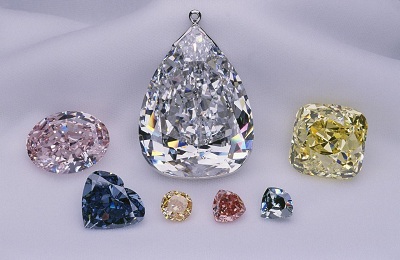
smooth cut– grinding the surface to revive the light of opaque stones. Types of smooth cutting: convex, smooth, ball, cabochon.
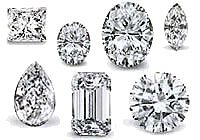
One of the main parameters that determine the value of a diamond is its cut. The appearance and properties of the processed diamond depend on it. This is a complex and painstaking robot, and the slightest mistake can ruin the future product.
History and modern types of cutting
Although mankind has been using diamonds for several millennia, their cutting became a common practice only a few centuries ago. Contrary to popular belief, these gems were first processed in Europe, not in India, and in the 14th century, not several millennia ago.
 The first "cutting" of a diamond was to smooth out too uneven surfaces of the stone to make it more transparent. As a result, the top of the mineral became sharper, so it was called "sharp stone". But in this case, the shape of the stone almost did not change, so it cannot be called a cut in the modern concept.
The first "cutting" of a diamond was to smooth out too uneven surfaces of the stone to make it more transparent. As a result, the top of the mineral became sharper, so it was called "sharp stone". But in this case, the shape of the stone almost did not change, so it cannot be called a cut in the modern concept.
The first steps towards modern diamond processing were made in the 16th century. It was then that the “platform cutting” became widespread. Its essence was the appearance at the bottom or top of the stone of a small platform, the so-called calleta, which was an additional facet.
Rose cut was also popular. The bottom of the stone was flat, and the upper part is processed in the form of a dome (the first steps in this direction were made in the 15th century). But such a diamond did not yet have 57 facets, so it cannot be fully considered as such.
Although it is no longer possible to name a specific master who initiated the form of cutting applied to diamonds today, the Venetian Vincenzo Peruzzi played a large role in this.
It was he who began to apply facets to the lower part of the diamond, made in the shape of a cone. The Peruzzi cut was later called "brilliant", but it still had 57 facets.
The 58 facet was added in the 19th century after the discovery of Brazilian diamond deposits. Although in this century, such a cut was considered another temporary fashion trend, it became a classic and has survived to this day.
In the 21st century, the following types of diamond cutting are most common:
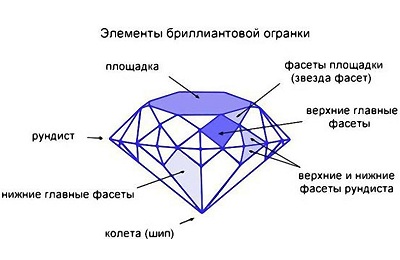
The variety of diamonds does not end there. Within the framework of one type of cut or by combining several at once, cutters have created dozens of various forms of these precious stones.
Popular Diamond Shapes
The shape of the cut is determined by the contour of the girdle. The girdle is the fine line that encircles the diamond. It also determines the upper and lower parts of the stone. The most popular cut shape is round. Such products are in great demand and are recognized by many masters as the most beautiful.
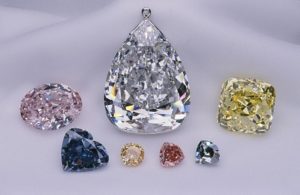 The generally accepted number of facets is fifty-seven. But how many facets of a diamond will be highlighted also depends on the size of the original diamond. To simplify, small stones are given 17 faces. At the same time, large round diamonds can have seventy-four or even one hundred and two facets (majestic cut).
The generally accepted number of facets is fifty-seven. But how many facets of a diamond will be highlighted also depends on the size of the original diamond. To simplify, small stones are given 17 faces. At the same time, large round diamonds can have seventy-four or even one hundred and two facets (majestic cut).
Among round diamonds, products with eighty-six facets stand out. A similar cut of diamonds is called royal. The lower part of such stones has thirty-six faces, the upper one - forty-nine. This form of cut is used in the processing of large stones, for which the application of fifty-seven facets would be inappropriate.
Among the large number of forms of diamonds, the following types should be distinguished:
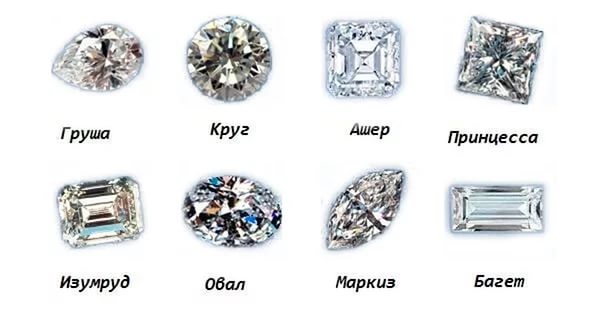
Rare diamond shapes include:
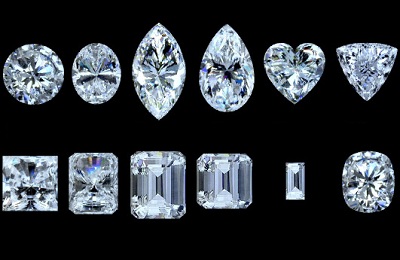
The specific shape of a diamond, as well as the number of its facets, affect the price of the stone. The least expensive jewelry is encrusted with 17 facets. In the manufacture of more expensive jewelry, diamonds are used with large quantity facets.
Diamond cutting: description of the process and its duration
Processing a diamond is a long and painstaking task. Any mistake in the cutting process can significantly reduce the cost of the final product, or even depreciate it. The modern processing process consists of the following steps:
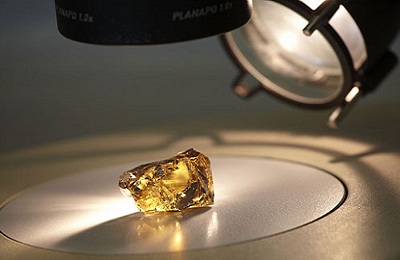
The first step is to inspect the source material. The specialist determines how best to process it, while paying attention to the defects present and uneven coloring. At this stage, possible forms of cutting diamonds are also selected.
During the markup, the specialist focuses on the defects present and selects a markup that will hide them. This procedure requires extensive experience and knowledge in the field of cutting, since it is at this stage that the properties of the future diamond are determined.
After marking, the original diamond is sawn into pieces, which will be further processed separately. When processing a diamond, experts try to use as much of its material as possible, so small diamonds with 17 facets can be produced from small parts. For cutting, special diamond blades are used, in some cases turning at a speed of up to eight thousand revolutions per minute. Water is used to cool the material being processed.
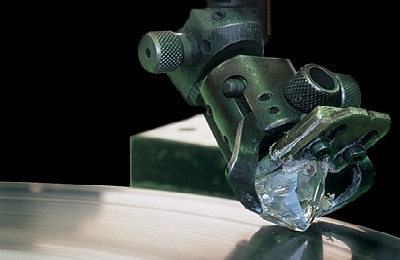 Next, parts of the sawn diamond are shaped in the roughing process. This is only a preliminary, rough form, but the contours of the future product begin to appear after this procedure. For peeling, a diamond cutter is used. In addition, this procedure can be carried out using a diamond-reinforced wheel.
Next, parts of the sawn diamond are shaped in the roughing process. This is only a preliminary, rough form, but the contours of the future product begin to appear after this procedure. For peeling, a diamond cutter is used. In addition, this procedure can be carried out using a diamond-reinforced wheel.
The most time-consuming and responsible part of diamond processing is grinding followed by polishing. For polishing precious stones, special machines are used, equipped with rotating cutting discs. At the same time, the diamond is attached to a special device that allows you to rotate it to the required angle. The upper faces are ground first, then the lower facets are ground.
After additional processing, which consists of washing, drying and boiling in sulfuric acid, the stones are graded and packaged. In most cases, the above procedures are carried out by different people. That is, before a diamond turns into a diamond, many specialists have time to work with it. This is especially true for large industrial enterprises,
It is impossible to specify the exact time for processing a diamond: this process consists of many stages and certain difficulties may arise at each of them. For example, in order to cut just one diamond, it may take from thirty minutes to several hours.
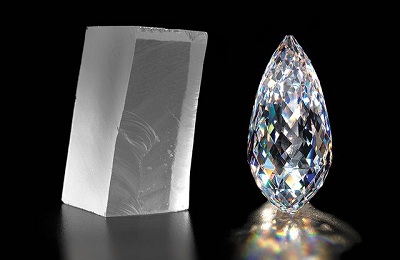 In special cases, this procedure may take several days. Some types of diamond cutting have to be done for several years. For example, it took two years to cut the Golden Jubilee stone, which was subsequently presented to the monarch of Thailand.
In special cases, this procedure may take several days. Some types of diamond cutting have to be done for several years. For example, it took two years to cut the Golden Jubilee stone, which was subsequently presented to the monarch of Thailand.
Cutting is considered a grinding process by which planes are applied to a diamond to give the stone various shapes. The applied planes are called faces or facets. As a result of cutting, the best properties of a diamond appear - color, brilliance, the “play” and “fire” of a diamond are revealed, at the same time, natural flaws, such as surface and internal defects, can be hidden. In the 21st century, three main types of cutting are used: brilliant cut , an old step cut and a mixed one, which was a combination of the first two types of diamond cut. Various combinations of cut diamond shapes and types of cut form a dozen popular diamond cut shapes. The name of a diamond cut is determined by the contour from the side of the platform and the number of facets, and the type of diamond cut is determined by the shape of the facets and the principle of their arrangement relative to each other. Until the 20th century, the rose cut was fashionable and popular, but it has ceased to be in demand since the advent of the modern brilliant cut.
Modern brilliant cut
round diamond
Diamond recognized as the most beautiful and frequently used form of brilliant cut, created for the optimal combination of brilliance and "play" of light, revealing the gem properties of the diamond. The light entering through the top platform into the diamond is refracted and reflected from the lower facets, turns into a rainbow and returns to the outside. The modern cut of round diamonds is usually associated with the name of Marcel Tolkowsky, who in 1919, based on the principle of total internal reflection and his calculations, proposed the geometric parameters of a round diamond, in which the optical properties of diamond are best manifested. Such a diamond is usually called ideal or classic. After Tolkowsky, many practitioners and scientists were engaged in solving the problem of calculating the rational proportions of an ideal diamond, taking into account not only the properties of diamonds, but also cutting traditions. Currently, there are four recognized types of round brilliant cut with 57 (58 facets are considered a diamond spike) facets: Tolkowski, Johnson and Röch, Eppler and Scandinavian brilliant cut.
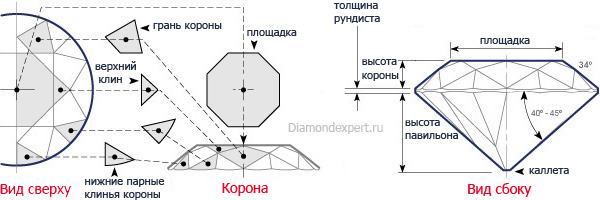
The structure of a diamond. The upper part of a round diamond is a crown.
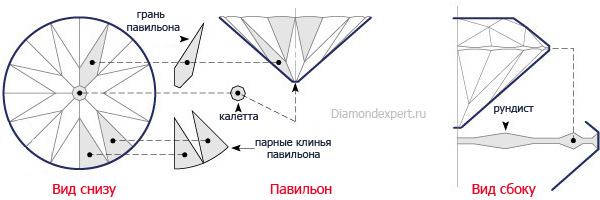
The structure of a diamond. The lower part of the round diamond is the pavilion.
Fantasy diamond cuts
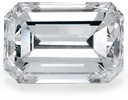
Step cut diamonds: Asher, Emerald.
Modified brilliant cut is one of the most common diamond cuts because the standard brilliant cut can be effectively modified into many different shapes while maintaining the same number of facets and arrangements relative to each other. Modified brilliant cut diamonds play and captivate with their flashes in much the same way as round brilliant cut diamonds.
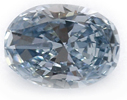
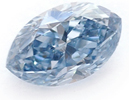
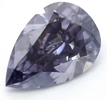
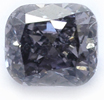
Fancy diamonds with altered brilliant cut: Oval, marquis, Pear, Heart, Cushion.
Mixed cut diamond combines the property of the stepped cut to retain the original weight of the diamond and the advantages of the brilliant cut in demonstrating the "play" and optical properties diamond. For the first time, mixed cutting appeared in the 60s of the last century - a stone with a brilliant-cut crown and a step-cut pavilion was shown to the public, at the same time, a diamond cut was introduced to the world. Princess, which has become so popular in our time that it is second only to the classic round brilliant cut.
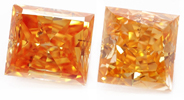
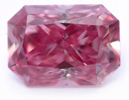
Mixed cut diamonds Princess, Radiant.
The search for the perfect diamond cut does not stop even in the 21st century. Application modern technologies modeling and accumulated knowledge about the diamond and the dynamics of the propagation of light allows you to invent new amazing
